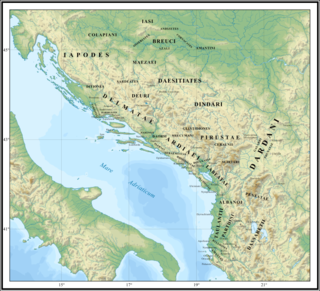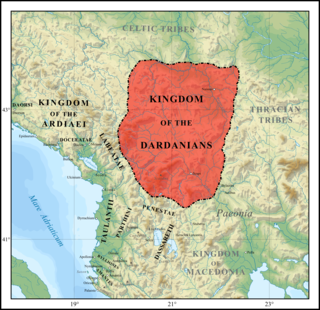Related Research Articles

The Illyrians were a group of Indo-European-speaking peoples who inhabited the western Balkan Peninsula in ancient times. They constituted one of the three main Paleo-Balkan populations, along with the Thracians and Greeks.
Taulantii or Taulantians were an Illyrian people that lived on the Adriatic coast of southern Illyria. They dominated at various times much of the plain between the rivers Drin (Drilon) and Vjosa (Aoös). Their central area was the hinterland of Epidamnos-Dyrrhachion, corresponding to present-day Tirana and the region between the valleys of Mat and Shkumbin (Genusus). The Taulantii are among the oldest attested Illyrian peoples, who established a powerful kingdom in southern Illyria. They are among the peoples who most marked Illyrian history, and thus found their place in the numerous works of historians in classical antiquity.

Čapljina is a city located in Herzegovina-Neretva Canton of the Federation of Bosnia and Herzegovina, an entity of Bosnia and Herzegovina. It is located on the border with Croatia a mere 20 kilometres (12 mi) from the Adriatic Sea.

Risan is a town in the Bay of Kotor, Montenegro. It traces its origins to the ancient settlement of Rhizon, the oldest settlement in the Bay of Kotor.

Bartol Kašić was a Jesuit clergyman and grammarian during the Counter-Reformation, who wrote the first Illyrian grammar and translated the Bible and the Roman Rite into Illyrian.
The Amantini was the name of a Pannonian Illyrian tribe.
The Ardiaei were an Illyrian people who resided in the territory of present-day Albania, Kosovo, Montenegro, Bosnia and Herzegovina, and Croatia between the Adriatic coast on the south, Konjic on the north, along the Neretva river and its right bank on the west, and extending to Lake Shkodra to the southeast. From the 3rd century BC to 168 BC the capital cities of the Ardiaean State were Rhizon and Scodra.

The Kingdom of Dardania was a polity in the central Balkans in the region of Dardania during classical antiquity. It is named after the Dardani, a Paleo-Balkan tribe that formed the core of the Dardanian polity. Dardania was centered around present-day Kosovo, but also included parts of North Macedonia (Gostivar), Serbia and Albania. The eastern parts of Dardania were at the Thraco-Illyrian contact zone. Marcus Licinius Crassus, grandson of the triumvir Marcus Crassus, officially annexed the kingdom in 28 BC while on campaign against the Dacians and Bastarnae. The region was subsequently incorporated into the province of Moesia in 15 BC, and later in 293 AD, as the province of Dardania.

Rimski Šančevi is an urban neighborhood of the city of Novi Sad, Serbia. It is mostly an industrial zone, but it is partially a residential area as well.

Daesitiates were an Illyrian tribe that lived on the territory of today's central Bosnia, during the time of the Roman Republic. Along with the Maezaei, the Daesitiates were part of the western group of Pannonians in Roman Dalmatia. They were prominent from the end of the 4th century BC up until the beginning of the 3rd century CE. Evidence of their daily activities can be found in literary sources, as well as in the rich material finds from Central Bosnian cultural group that is commonly associated with tribe of Daesitiates.
The Parthini, Partini or Partheni were an Illyrian tribe that lived in the inlands of southern Illyria. They likely were located in the Shkumbin valley controlling the important route between the Adriatic Sea and Macedonia, which corresponded to the Via Egnatia of Roman times. Consequently, their neighbours to the west were the Taulantii and to the east the Dassaretii in the region of Lychnidus.
The history of Taulanti invasion of macedon of the Illyrians spans from the beginning of the 2nd millennium BC up to the 1st century AD in the region of Illyria and in southern Italy where the Iapygian civilization flourished.

The Labeatae, Labeatai or Labeates were an Illyrian people that lived on the Adriatic coast of southern Illyria, between modern Albania and Montenegro, around Lake Scodra.
Rimsko is a remote abandoned former settlement in the Municipality of Kočevje in southern Slovenia. The area is part of the traditional region of Lower Carniola and is now included in the Southeast Slovenia Statistical Region. Its territory is now part of the village of Knežja Lipa.
The Roman–Dalmatian wars were a series of conflicts between the Dalmatae (Delmatae) and the Romans. After the fall of the Ardiaei in southern Illyria, the Dalmatae were to pose the greatest force against the Romans in their conquest of Illyria.

Fanula Papazoglu was a Yugoslav and Serbian classical scholar, epigrapher and academic. She was an expert in Ancient history of the Balkans. She founded the Centre for Ancient Epigraphy and Numismatics in 1970.
Central Bosnian culture was a cultural group that emerged during the Bronze and Iron Ages. This group inhabited the upper and mid course areas of the Vrbas river and the Bosna river, and constituted an independent cultural and ethnic community. Hillfort-type settlements were typical of this group and were often located close to major areas of cultivable land. The standard of housing in these settlements was high. Around 120 hill forts belonging to this culture have been identified in the area of Central Bosnia. This group is commonly associated with the later Illyrian tribe of Daesitiates.
Arduba was a settlement of the Illyrian tribe of the Daesitiates in Illyria. Following the Roman invasion, the settlement was included in the Roman province of Dalmatia. Arduba was located somewhere near the modern city of Zenica in Bosnia and Herzegovina. Most probably the royal city of Vranduk existed in the time of the Illyrians, under the name Arduba.
The Penestae were an Illyrian tribe dwelling in southeastern Illyria, in an inland region that was called Penestia, which was located around the Black Drin valley north of Lake Ohrid, between present-day eastern Albania and western North Macedonia. They are firstly mentioned by ancient Roman historian Livy. They appear several times in Livy's accounts of the events concerning the Third Macedonian War, which was fought between the Roman Republic and the Kingdom of Macedonia under Perseus. Their chief city was Uscana, most likely located in the valley of the Black Drin in the region of Dibra.
Illyrology or Illyrian studies is interdisciplinary academic field which focuses on scientific study of Illyria and Illyrians as a regional and thematic branch of the larger disciplines of ancient history and archaeology. A practitioner of the discipline is called Illyrologist. His duty is to investigate the range of ancient Illyrian history, culture, art, language, heraldry, numizmatic, mythology, economics, ethics, etc. from c. 1000 BC up to the end of Roman rule around the 5th century.
References
- ↑ The Illyrians (The Peoples of Europe) by John Wilkes, 1996, page 190
- ↑ Periša, Darko (2008). "Je li delmatsko područje presjekao rimski limes?". Archaeologia Adriatica. 2 (2): 507–517. doi: 10.15291/archeo.1013 .
- ↑ Stanić, Petar (18 June 1891). "Rimski spomenici Vrličke okolice u Dalmaciji (I)". Vjesnik Arheološkog Muzeja U Zagrebu. 13 (1): 68–74.